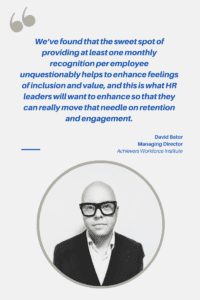Research shows that driving better retention and attraction involves creating a sense of belonging for employees–here’s how to improve it at your organization
By Zee Johnson
The events of recent years have caused workers to reevaluate what’s important to them–a sentiment that ultimately led to millions 
Recent research from Achievers Workforce Institute revealed that 41% of employees don’t feel valued at all. Another 41% of respondents say that they lack workplace support for achieving their goals, both personal and professional.
Achievers Workforce Institute’s Managing Director David Bator defines belonging as an experience of connection, security, and community and says research reveals the key components: being welcomed, known, included, connected, and supported. Organizations need to provide holistic and comprehensive support for employees to ensure they feel cared for, well resourced, and able to receive help when needed.
“We surveyed thousands of employees in many global regions multiple times and found that, in general, employees want to be engaged and retained just as much as HR leaders want to engage and retain them,” he says. “They want balance, growth, and support as they reflect on the deeper value and meaning of work.”
Unfortunately, there is a major gap between what employees want and what organizations are delivering. Achievers Workforce Institute research finds just 26% of employees feel a sense of belonging at their organizations and it’s even less among junior-level employees, with only 15% agreeing.
“We identified a consistently high level of disconnect inside organizations with HR leaders believing they are implementing the right supports for employees, while employees reported that programs are not impactful,” he says. “Closing this gap is critical to ensuring investments are having the intended results–and the only way to do that effectively is for organizations to make a commitment to regularly ask employees what they want and need.”
Bator outlines the ways employers can improve belonging at their organization:
- Use data to make progress on important business goals. The more information about how your employees are doing, the better. Understanding where everyone is at with regard to feeling welcome, known, included, connected, and supported at your organization will help you understand where you are at with regard to initiatives such as DEI and well-being so you can get closer to your culture-building objectives.
- Listen to all employees, including absolutely everyone–and especially those who are unique. Bator says today’s employees are increasingly coming to expect their voice to be heard by their employers. Organizations that implement a powerful voice-of-employee (or VOE) strategy will certainly have a competitive advantage in this new world of work.
- Ask for feedback regularly and take action on that feedback. Only half of employees say they’ve been asked their opinion about company culture and just 18% of that number say their company actually takes action based on that feedback. Employees don’t mind being surveyed often; it’s a myth that they do. On the contrary, it’s “inaction fatigue” that is harmful. When organizations don’t take the time to address voice-of-employee feedback with meaningful solutions, it results in higher churn rates and frustrated talent attraction efforts.
- Recognize and reward employees for their hard work and commitment to the organization. Social recognition is a game-changer. It is one of the best and least expensive ways to keep employee morale and engagement high. Move beyond years-of-service awards and start recognizing positive behavior in real time to see improved employee performance. But practice both social and monetary recognition with an integrated program for maximum impact for your employees and your initiatives.
Bator says that a well-thought-out recognition strategy to welcome, get to know, connect, include, and support employees empowers them with a sense of belonging.
“It’s the number-one ask of employees: they want more direct recognition from their managers,” he says. “Employees recognized weekly are five times less likely to job hunt regularly compared to those never recognized. We’ve found that the sweet spot of providing at least one monthly recognition per employee unquestionably helps to enhance feelings of inclusion and value, and this is what HR leaders will want to enhance so that they can really move that needle on retention and engagement.”
In today’s labor shortage, it’s important now more than ever for HR leaders to ensure employees feel their organization provides them with the right support and tools to lead them to success, belonging, and empowerment. Recognition, employee feedback, and its resulting data insights can not be overlooked as key factors guiding HR strategies that truly support the entire business.















